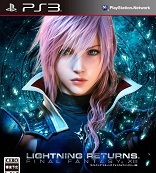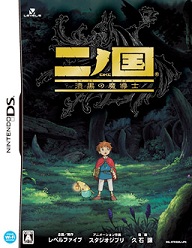Dragon Quest VIII: Journey of the Cursed King
PlayStation 2
Reviewed: 12/15/2005
 |
The Dragon Quest series has had a turbulent history in North America. It has a reputation for being about as old school as you can get, and many say this is why it hasn’t sold well in the west. Now some years have past, a company merger has occurred, and development of the game has been outsourced to Level 5. Does this mean Dragon Quest has lost its soul? It sure doesn’t seem that way. Dragon Quest VIII is here to tell you that if old school is bad it doesn’t want to be good.
The very first thing you’ll notice about Dragon Quest VIII is how it looks. The developers have opted for a cel-shaded look to the game that fits the design incredibly well. The level of detail to be found is amazing at times. Dungeons and towns are all uniquely designed and sprawling. Every town feels like someplace where people actually live, and they are dressed up with enough rooms and furniture to make you believe it. Some of the larger castles are especially huge and complex. Add to this the fact that every single portion of Dragon Quest VIII acts as one continuous world. The sheer wonder of climbing to the top of a high tower or hill and looking down at the landscape stretching off out of sight is abundant everywhere. Players will often find themselves just looking around to see everything they can, and boy is there a lot to see. The towns and dungeons are huge enough, but the world map puts them to shame. Those who have been complaining at the lack of truly explorable world maps in RPGs lately are about to have their minds blown. Gone are the days when our hero exits a town to find himself as large as the selfsame town he just exited. Large buildings, mountains, and trees loom above the hero, finally giving us a reason why we can’t just walk over those tiny little mountains. Let’s not forget the variety present on the world map, either. Players can (and will) walk through all four seasons in their journey.
 |
| Yangus has much wisdom to share throughout the game. |
The characters are also brought to life incredibly well. There are little details everywhere in their animation that add up to have one big effect on bringing the world to life. When the hero goes up to a bookshelf he quickly scans to see if there’s anything useful, and if there is he’ll grab it off the shelf and scan through it. Another small but exciting detail is the fact that your equipped weapons actually show up on your characters in and out of battle. This holds true for cutscenes as well, and really adds a level of satisfaction to players when they have a cool looking weapon equipped. The enemies are also brought to life with gorgeously smooth animation when idling or attacking. Some may question the rather cartoony design of most of the monsters, but the mild humor inherent in them helps the battles to never get old. Speaking of battles…
The battle system in Dragon Quest VIII is about the same as every previous game, with the exception of tension. Tension allows characters to build up their power to unleash a more devastating attack the next round. This applies for both physical attacks and some magic, so it can be incredibly useful at times. Otherwise, the battle system is pretty simple. The entire thing is completely turn-based, with turn order being determined by the characters’ agility stat. Some people might think there can be no depth in such a battle system, but the developers managed to make battles that require quite a bit of strategy with this system. For most of the later bosses, without excessive levelling, players are going to need a good strategy going in or they’re going to have to be cleaned off the walls.
Characters learn new abilities and gain proficiency in weapons through the skill system. Every time characters level up, they get a certain number of skill points which players can put into five different skills. Each character has three weapons skills, a fisticuffs skill for barehand fighting, and a special skill unique to them. This opens up many ways the game can be played, and usually every player I’ve seen has done it a slightly different way. It also forces some tough decisions out of players, because skill points don’t come cheap. Even if someone were to level up to 99 (an already enormous undertaking as the average level at game completion is around 40) they would still not have enough to max out all the skills. So, considering that in the course of normal gameplay there’s only going to be one or two skills a given character can get their hands in, those skills better be chosen wisely.
Another fun game system is the alchemy pot. At a certain point in the journey this pot is acquried and allows players to do item synthesis. This system is rather interesting, because the results are not instantaneous. Players must walk around for a few minutes before their creation is complete. This can sometimes be an annoyance when a really great piece of armor finishes cooking while in a dungeon, since the pot cannot be accessed from there. There are also the Infamous Monsters who roam the world map. After gaining access to the Monster Arena, these monsters can be defeated and recruited to a monster team. This monster team can fight in tournaments to win prizes and cool bonuses, such as the ability to call the monster team in battle. Casinos are also a fun distraction from the main game, and can be quite lucrative too. Monsters never really give much gold in the game, so usually players are left with the alchemy pot and gambling to earn their living.
 |
| The world is just so large and fun to explore. |
The game begins in a forest clearing, where we meet our hero, King Trode, Yangus, and the Princess Medea, who is currently a horse. It seems the kingdom of Trodain has come under an awful curse by some jester/magician named Dhoulmagus and they’ve just recently set off to find him and a way to break the curse. This same curse is responsible for King Trode looking like some weird green monster and the princess for being a horse. Two other characters, named Jesscia and Angelo, will be joining the band a little later in the game. All of these main characters are fun and have some real chemistry going on. The same can be said of the many other characters the band will meet along their journey, whether they be blind old sages or local fortune tellers. The story can be generic and predictable at times, but manages to overcome this by being expertly told. It may just be the immersiveness of the world, but players can really get caught up in the story. The characters and their problems feel remarkably real and fleshed out. The story is rather episodic in nature, with short term goals taking up the brunt of what the characters will be doing. There is always, however, the long-term goal of breaking the curse that has been put on the kingdom or Trodain.
The music in Dragon Quest VIII is of a different breed than most other RPGs. The world map music evokes a sense of exploration and determination to get to the next destination. Battle music is bombastic, menacing, and seldom got old despite the large amount of time spent fighting. Town music is quietly subdued or grand, depending on the kind of town currently being visited. Everything is as it should be, and the soundtrack gets across the emotion of the various places very well. It’s a different style than most are used to, but it works very well with the game. For the North American release it was decided to include fully orchestrated versions of the game’s many tunes. This makes an already good score even better and will leave many wondering why more RPG soundtracks don’t go this route.
 |
| Best. Staring. Contest. Ever. |
Besides the orchestral score, another thing added to the North American version was voice acting. This has always been a tricky area in games, but Dragon Quest VIII pulled it off extremely well. The voices of the main characters are acted well, and fit their personalities. The voices really bring the characters to life more than they already are, and is a nice addition overall. Some of the more minor characters, however, introduce a mixed bag. Chances are if the character is mostly important they’ll be voiced pretty well, but if it’s just some NPC, ears may bleed. Overall, they did a better job here than most do these days.
Dragon Quest VIII has proved to the world that there’s nothing really wrong with being old school. Content-wise there’s enough here to keep someone busy for months. The average play-time seems to be somewhere around 80 hours, not counting the extra things that become available after beating the game. Dragon Quest VIII has earned its place as one of the greatest RPGs of all time. It’s not just a game, it’s an entire world.
-Orie House
| Score Breakdown | ||
| Overall Excellent Out of 10 See our Review Criteria |
Gameplay | Great |
| Story | Excellent | |
| Graphics | Legendary | |
| Sound/Music | Great | |
| Replay Value | Very Good | |
| The Verdict: 9 | ||








